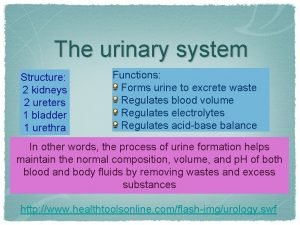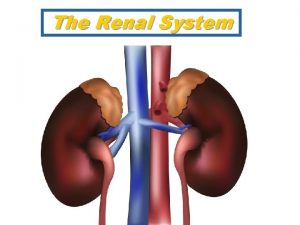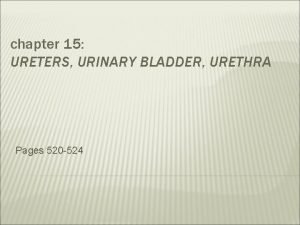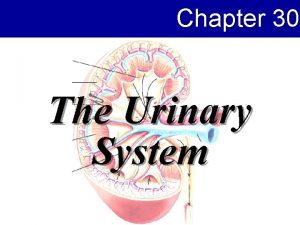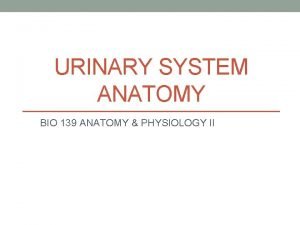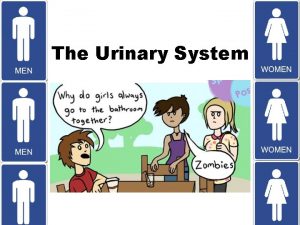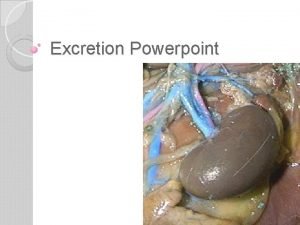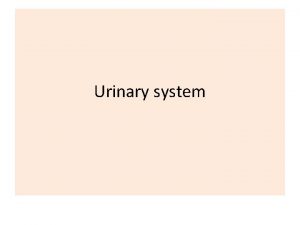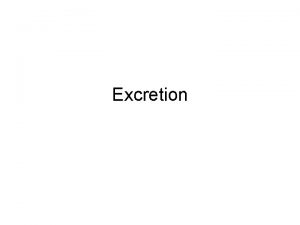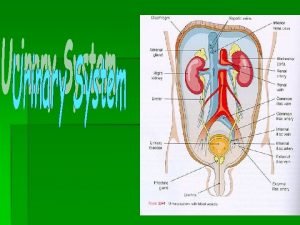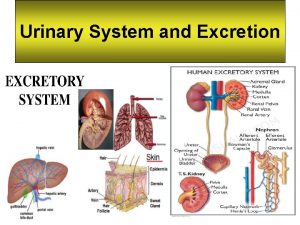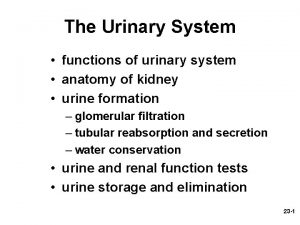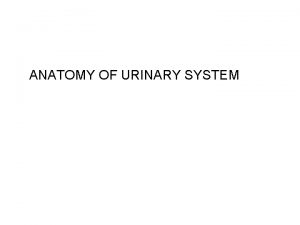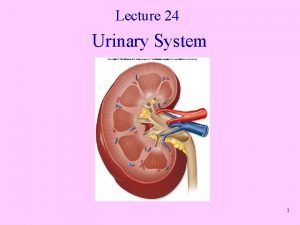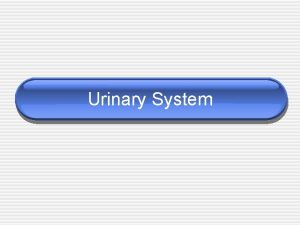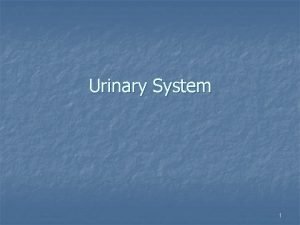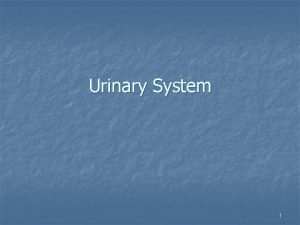HUMAN ANATOMY LECTURE TWENTY URINARY SYSTEM FUNCTIONS Excretion

















- Slides: 17

HUMAN ANATOMY LECTURE TWENTY URINARY SYSTEM

FUNCTIONS • Excretion - removing waste products from the blood • Blood volume control - regulating urine production (H 2 O loss) • Ion concentration regulation - Na+, Cl-, K+, Ca+2, HPO 4 -2 • p. H regulation - p. H of extracellular fluid by controlling H+ and HCO 3 loss in urine • Nutrient conservation - preventing excretion of required substances • Red blood cell concentration • Vitamin D synthesis

KIDNEY ANATOMY LOCATION • Bean-shaped organs lying behind the peritoneum (retroperitoneal) on the posterior abdominal wall on either side of the vertebral column • Protected by lumbar vertebrae and rib cage • Right kidney is slightly lower than left EXTERNAL ANATOMY • Superior surface capped by adrenal gland • Surrounded by RENAL CAPSULE fibrous connective tissue layer


• RENAL FAT PAD around renal capsule for protection • RENAL FASCIA - dense fibrous connective tissue outer layer anchors kidney to surrounding structures • HILIUM - on medial side where nerves and blood vessels enter and exit - opens into RENAL SINUS (cavity filled with adipose tissue and loose C. T. ) INTERNAL ANATOMY • Outer RENAL CORTEX • Inner RENAL MEDULLA surrounding renal sinus • RENAL PYRAMIDS - triangle shaped structures at boundary of cortex and medulla with tips projecting toward hilium

• Apex of renal pyramid is RENAL PAPILLA - projects into renal sinus • RENAL COLUMNS separate the renal pyramids • RENAL LOBES consist of renal pyramid, area of renal cortex surrounding renal columns • Urine drains from renal papilla into MINOR CALYX, 4 -5 then drain into a MAJOR CALYX, 2 -3 drain into the RENAL PELVIS • URETER drains the renal pelvis, exiting through the hilium to the URINARY BLADDER

NEPHRON • Microscopic functional unit of the kidney • Production of urine • Bowman’s capsule, proximal and distal tubules - within renal cortex • Loop of Henle, collecting ducts, and papillary ducts - within renal medulla

RENAL CORPUSCLE Made up of Bowman’s capsule and glomerulus BOWMAN’S CAPSULE • Outer parietal layer - simple squamous epithelium becomes cuboidal where Bowman’s capsule ends and proximal tubule begins • Inner visceral layer - specialized podocytes (large cells with “feet”) that wrap around the glomerulus GLOMERULUS • Network of capillaries that form a ball surrounded by Bowman’s C.

GLOMERULAR CIRCULATION • AFFERENT ARTERIOLE - supplies blood to glomerulus from renal artery • EFFERENT ARTERIOLE - drains glomerulus and branches into … • PERITUBULAR CAPILLARIES - form a plexus surrounding the proximal and distal tubules and upper area of loop of Henle • VASA RECTA - specialized areas of the peritubular capillaries that extend into medulla and surround loop of Henle

JUXTAGLOMERULAR APPARATUS • Specialized structure where distal tubule projects between afferent and efferent arterioles and Bowman’s capsule • Endocrine structure that secretes erythropoietin (hormone) and renin (enzyme) • Macula densa - dense connective tissue with tall cells and clustered nuclei associated with smooth muscle fibers (juxtaglomerular cells) in wall of afferent arteriole

FILTRATION MEMBRANE • FENESTRAE - window-like openings in the endothelial cells of the glomerular capillaries • FILTRATION SLITS - gaps between the cell processes of podocytes - basement membrane sandwiched between endothelial cells of glomerular capillaries and podocytes • FILTRATION MEMBRANE - glomerular capillary endothelium, basement membrane, podocytes - first stage of urine formation occurs here when fluid from blood in capillaries moves across filtration membrane into the Bowman’s capsule

PROXIMAL TUBULE • Connected to Bowman’s capsule • Lining is simple cuboidal epithelium with microvilli for absorption of nutrients, ions, water, plasma proteins from the blood LOOP OF HENLE • Descending limb - first portion similar in structure to proximal tubule - latter portion simple squamous epithelium and thinner (permeable to water) • Ascending limb - first portion simple squamous epithelium and thin - later portion thicker and simple cuboidal

DISTAL TUBULE • Initial segment passes between the afferent and efferent arterioles (near juxtaglomerular apparatus) • Smaller diameter and simple cuboidal cells with few microvilli • Site of secretion of ions, drugs, acids, toxins, selective reabsorption of ions, and water COLLECTING DUCT • Many distal tubules drain into • Larger in diameter with simple cuboidal epithelium • Several collecting ducts drain into larger PAPILLARY DUCT that empties into a minor calyx

URINE FORMATION

URETERS • Muscular tubes extending from kidneys to urinary bladder • Begins with funnel-shaped renal pelvis within kidney • Lined with transitional epithelium (specialized to stretch) inside walls of smooth muscle

BLADDER • Hollow triangle-shaped muscular container lying in pelvic cavity just posterior to pubic symphysis • Held in place by umbilical ligaments • Stores urine - lined with transitional epithelium and rugae to stretch • Trigone - interior triangular area between ureter opening and exit of urethra (acts as a funnel) • Internal urethral sphincter at neck of bladder - in males keeps semen from entering bladder

URETHRA • Extends from urinary bladder to outside body • In males – divided into prostatic urethra (through center of prostate gland), membranous urethra (penetrates floor of pelvic cavity), spongy urethra (through penis) • Passes through urogenital diaphragm (circular band of skeletal muscle) that form the external urethral sphincter - under voluntary control • Lining is stratified columnar and then stratified squamous epithelium with elastic connective tissue
 What is the name
What is the name Kidney in human body
Kidney in human body Urethra
Urethra Lymph tissue fluid
Lymph tissue fluid 01:640:244 lecture notes - lecture 15: plat, idah, farad
01:640:244 lecture notes - lecture 15: plat, idah, farad Introduction of urinary system
Introduction of urinary system Glomerular filtration
Glomerular filtration Hyperproteinuria word parts
Hyperproteinuria word parts Whats gametes
Whats gametes Fetal pig masseter muscle
Fetal pig masseter muscle Chapter 30 the urinary system
Chapter 30 the urinary system Kidney pyramid labeled
Kidney pyramid labeled Chapter 20 urinary/excretory system
Chapter 20 urinary/excretory system Urinary system model
Urinary system model Urinary system fun fact
Urinary system fun fact Alimentary canal
Alimentary canal Urinary system powerpoint
Urinary system powerpoint The urinary system is also known as
The urinary system is also known as
